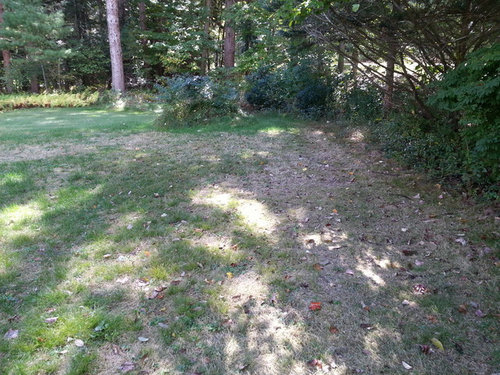2nd year in a row lawn dying need help
joejkd
10 years ago
Related Stories

HOUZZ TOURSMy Houzz: 38 Years of Renovations Help Artists Live Their Dream
Twin art studios. Space for every book and model ship. After four decades of remodeling, this farmhouse has two happy homeowners
Full Story
BASEMENTSRoom of the Day: Swank Basement Redo for a 100-Year-Old Row House
A downtown Knoxville basement goes from low-ceilinged cave to welcoming guest retreat
Full Story
FALL GARDENINGReflecting on a Gardening Year
Mistakes and successes, surprises and comforts. The garden helps us grow in new ways every year
Full Story
GARDENING GUIDES8 Unthirsty Plants Help You Save Water in Style
Spend less effort and money on your landscape with drought-tolerant and native plants that liven up your yard
Full Story
GREAT HOME PROJECTSHow to Replace Your Lawn With a Garden
New project for a new year: Lose the turfgrass for energy savings, wildlife friendliness and lower maintenance
Full Story
EARTH DAYThe Case for Losing the Traditional Lawn
Work less, help the environment and foster connections by just saying no to typical turf
Full Story
SAVING WATERHouzz Call: Are You Letting Go of Your Lawn?
Many facing a drought are swapping turf for less thirsty plantings. If you’re one of them, we’d like to hear about it
Full Story
PETSHow to Help Your Dog Be a Good Neighbor
Good fences certainly help, but be sure to introduce your pup to the neighbors and check in from time to time
Full Story
GARDENING GUIDES15 Ideas to Try in Your Garden This Year
These gardening stories were tops among Houzz readers. Which ideas might you try this year?
Full Story
GARDENING GUIDESHow to Plant a New Lawn From Sod
Take the quick-start route to turf with sod; these installation guidelines will help ensure a healthy and long-lasting lawn
Full StoryMore Discussions









agray132
joejkdOriginal Author
Related Professionals
Edmond Landscape Architects & Landscape Designers · Cottonwood Landscape Architects & Landscape Designers · Essex Landscape Architects & Landscape Designers · Cicero Landscape Contractors · Darien Landscape Contractors · Homewood Landscape Contractors · Mount Kisco Landscape Contractors · Nanuet Landscape Contractors · Ringwood Landscape Contractors · Riverview Landscape Contractors · Waterford Landscape Contractors · York Landscape Contractors · Lauderdale Lakes Landscape Contractors · Rowlett Swimming Pool Builders · Weatherford Swimming Pool Buildersdchall_san_antonio
joejkdOriginal Author
dchall_san_antonio